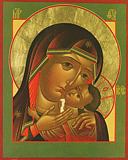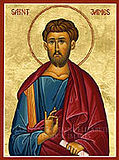

| Previous day | Next day |
| Old Style
October 9
|
Tuesday |
New Style
October 22
|
| 18th Week after Pentecost. Tone 8. | No fast.
|
![]() Holy Apostle James, son of Alphaeus (1st c.).
Holy Apostle James, son of Alphaeus (1st c.). ![]() St. Andronicus and his wife St. Athanasia, of Egypt (5th c.).
St. Andronicus and his wife St. Athanasia, of Egypt (5th c.).
Righteous Forefather Abraham and his nephew Righteous Lot (ca. 2000 b.c.). Martyrs Juventinus and Maximinus, soldiers, at Antioch (361-363). St. Publia the Confessor, deaconess, of Antioch (361-363). St. Peter of Galatia (9th c.).
Uncovering of the relics of New Hiero-confessor Sebastian (Fomin), archimandrite, of Optina and Karaganda (1997).
Icons of the Most Holy Theotokos “Korsun” (Kherson) and “Assuage My Sorrow.” (988, 12th c.)
St. Demetrius, bishop of Alexandria (231). Hieromartyr Dionysius (Denis) of Paris, bishop (ca. 258) Blessed Stephen Lazarevic, king of Serbia (1427). St. Stephen the Blind, king of Serbia (1468).
Thoughts for Each Day of the Year
According to the Daily Church Readings from the Word of God
By St. Theophan the Recluse

Tuesday. [Col. 1:1-2, 7-11; Luke 8:1-3]
The Lord preaches, the women serve Him from their substance, and are thus as participants in his very preaching. It is not given to everyone to preach the Gospels, but everyone can help spread them, and be participants in this most important matter on the earth. There were many such participants, both men and women, at the time the holy apostles preached; and then at the time of their successors, and finally, throughout the entire history of the Church. Such participants exist to this day. Our apostles in the Caucasus and in various areas of Siberia labour zealously, suffering every need and deprivation. They continue the work of the Lord and the holy Apostles. Those men and women who send them help join the ranks of the women who served the Lord, and become worthy of equal recompense. The Lord said: He that receiveth whomsoever I send receiveth Me (John 13:20). This means that He equates Himself with the one who is sent to preach; it would follow that He equates the service rendered to his messengers with serving Him. According to the law of His goodness and truth, the way a person receives one determines the reward he will receive (Matt. 10:41). This would seem to be sufficient incentive to keep giving alms to help in the great work of preaching of the Gospels.
Articles
 Apostle James the Son of AlphaeusHoly Apostle James the son of Alphaeus one of the Twelve Apostles, was the brother of the holy Evangelist Matthew. |
 Righteous Forefather AbrahamThe Righteous Forefather Abraham lived around 2000 B.C. His story is found in the Book of Genesis, Chapters 12-25. |
 Martyrs Juventius and Maximus at AntiochMartyrs Juventinus and Maximus at Antioch were bodyguards of the emperor Julian the Apostate (361-363). |
 Icon of the Mother of God of KorsunThe Korsun Icon of the Mother of God is believed to be one of those painted by the holy Evangelist Luke, and it had been preserved in Ephesus. |
 Saint Stephen of Serbia, “the blind one”Saint Stephen Brancovich was the son of the Despot George and Queen Irene, and lived in the fifteenth century. |






